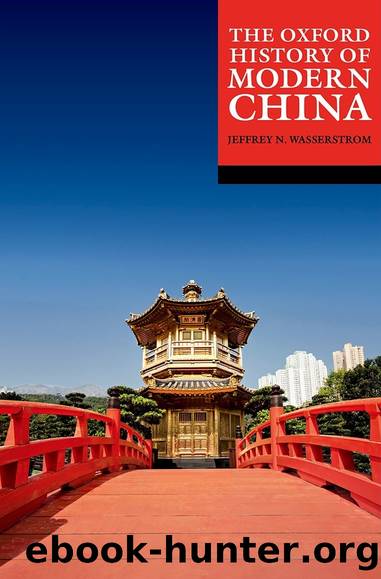The Oxford History of Modern China by Jeffrey N. Wasserstrom

Author:Jeffrey N. Wasserstrom [Wasserstrom, Jeffrey N.]
Language: eng
Format: epub
ISBN: 9780192648303
Publisher: OxfordUP
Published: 2021-12-09T00:00:00+00:00
Radical Cultural Revolution, 1966â1968
In the stand-off leading up to the Cultural Revolution, Maoâs rivals controlled Beijing and its national media. Maoâs initial political base was Shanghai, where writers associated with Jiang Qing were protected by local politicos who threw their support behind Mao. Debates were heated, yet opaque. Encouraged by Mao, critic Yao Wenyuan attacked a 1961 drama, Hai Rui Dismissed from Office. Despite its Ming dynasty setting, the play was read as a critical allegory of Maoâs purge of Defense Minister Peng Dehuai for resisting the Great Leap Forward. Its author was deputy mayor of Beijing, and this drama review signaled to the nation that Beijingâs mayor Peng Zhen could not protect his own entourage, and was thus next to be purged himself. Sowing chaos in the capital, Maoists were better able then to attack their major targets, President Liu Shaoqi and Secretary General Deng Xiaoping.
The Red Guards became the shock troops for the Cultural Revolution, which the Party Central Committee declared on May 16, 1966. Most Red Guards were urban high school students. A 16-year-old Red Guard would have been born in 1950, and personally unfamiliar with the revolution. Red Guards were not organized by the state but sprang up spontaneously, drawn into politics by controversies within their schools, and by the excitement of breaking down established routines.
Peace and economic growth had led to a large demographic increase in the numbers of young Chinese. Schools expanded, fueling ambitions for good, non-agricultural jobs. But new graduates faced limited opportunities because the 1949 revolution installed a cohort of relatively young leaders, many still on the job. Thus the political ideals of the young were joined by anxieties about their personal futures; Maoist politicians channelled this explosive combination.
Mao Zedong, although 72, reached out to Chinaâs youth through a highly publicized swim in the Yangzi River. Millions of young people responded with a sudden fad for swimming. Well-staged mass rallies of Red Guards in Tiananmen Square continued the momentum. Mao wore the Red Guard armband and wrote his own âbig character poster,â showing his respect for the tens of thousands of revolutionary declarations that young rebels pasted on public walls.
These big character posters ranged from high-blown polemics to revelations of apparently scandalous political behavior by officials under attack. Posters were supplemented by Red Guard newspapers and magazines. Maoist officials often leaked documents to Red Guards in order to damage their adversaries through new media, beyond the control of conservative bureaucrats. This information was generally accurate, although often taken out of context and given the most damaging interpretation.
The Red Guards combined political zeal with teen rebellion, breaking social barriers as they looked for ways to promote revolution. Maoists ordered Chinaâs railroads to provide free transportation to Red Guards in the autumn of 1966, in order to encourage the âexchange of revolutionary experiences.â Whatever the political motives of adult Maoist politicians, this ârevolutionary tourismâ allowed young people their first opportunity to travel.
Some of the early Cultural Revolutionâs shocking violence flowed from the fact that no one dared oppose the gangs of students, for fear of being labeled a counterrevolutionary.
Download
This site does not store any files on its server. We only index and link to content provided by other sites. Please contact the content providers to delete copyright contents if any and email us, we'll remove relevant links or contents immediately.
| Central Asia | Southeast Asia |
| China | Hong Kong |
| India | Japan |
| Korea | Pakistan |
| Philippines | Russia |
The Sympathizer by Viet Thanh Nguyen(4308)
The Rape of Nanking by Iris Chang(4140)
World without end by Ken Follett(3432)
Ants Among Elephants by Sujatha Gidla(3417)
Blood and Sand by Alex Von Tunzelmann(3140)
Japanese Design by Patricia J. Graham(3112)
City of Djinns: a year in Delhi by William Dalrymple(2516)
The Queen of Nothing by Holly Black(2499)
Foreign Devils on the Silk Road: The Search for the Lost Treasures of Central Asia by Peter Hopkirk(2434)
India's Ancient Past by R.S. Sharma(2417)
Inglorious Empire by Shashi Tharoor(2396)
Tokyo by Rob Goss(2390)
In Order to Live: A North Korean Girl's Journey to Freedom by Yeonmi Park(2348)
India's biggest cover-up by Dhar Anuj(2319)
Tokyo Geek's Guide: Manga, Anime, Gaming, Cosplay, Toys, Idols & More - The Ultimate Guide to Japan's Otaku Culture by Simone Gianni(2316)
The Great Game: On Secret Service in High Asia by Peter Hopkirk(2305)
Goodbye Madame Butterfly(2209)
Batik by Rudolf Smend(2128)
Living Silence in Burma by Christina Fink(2038)
